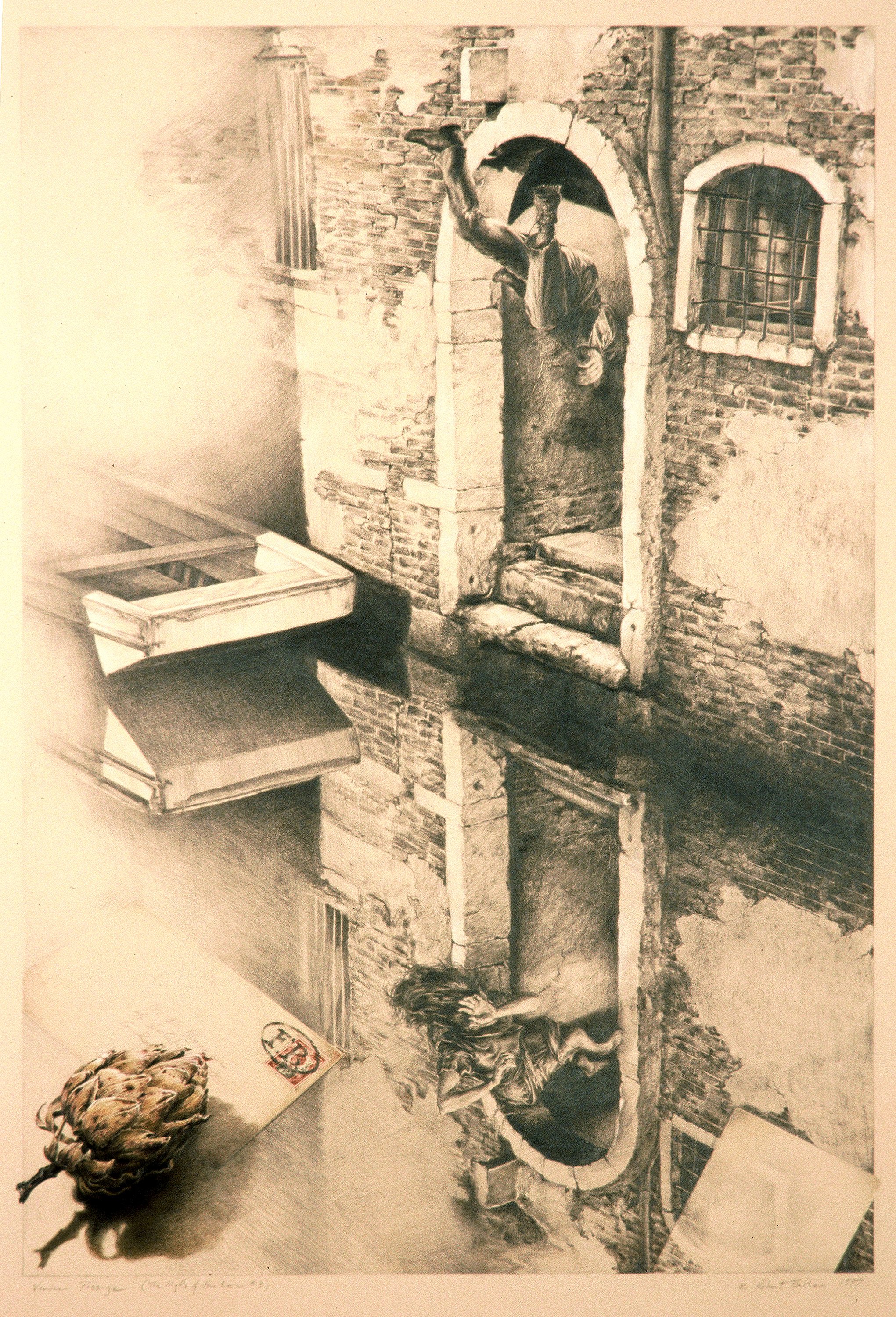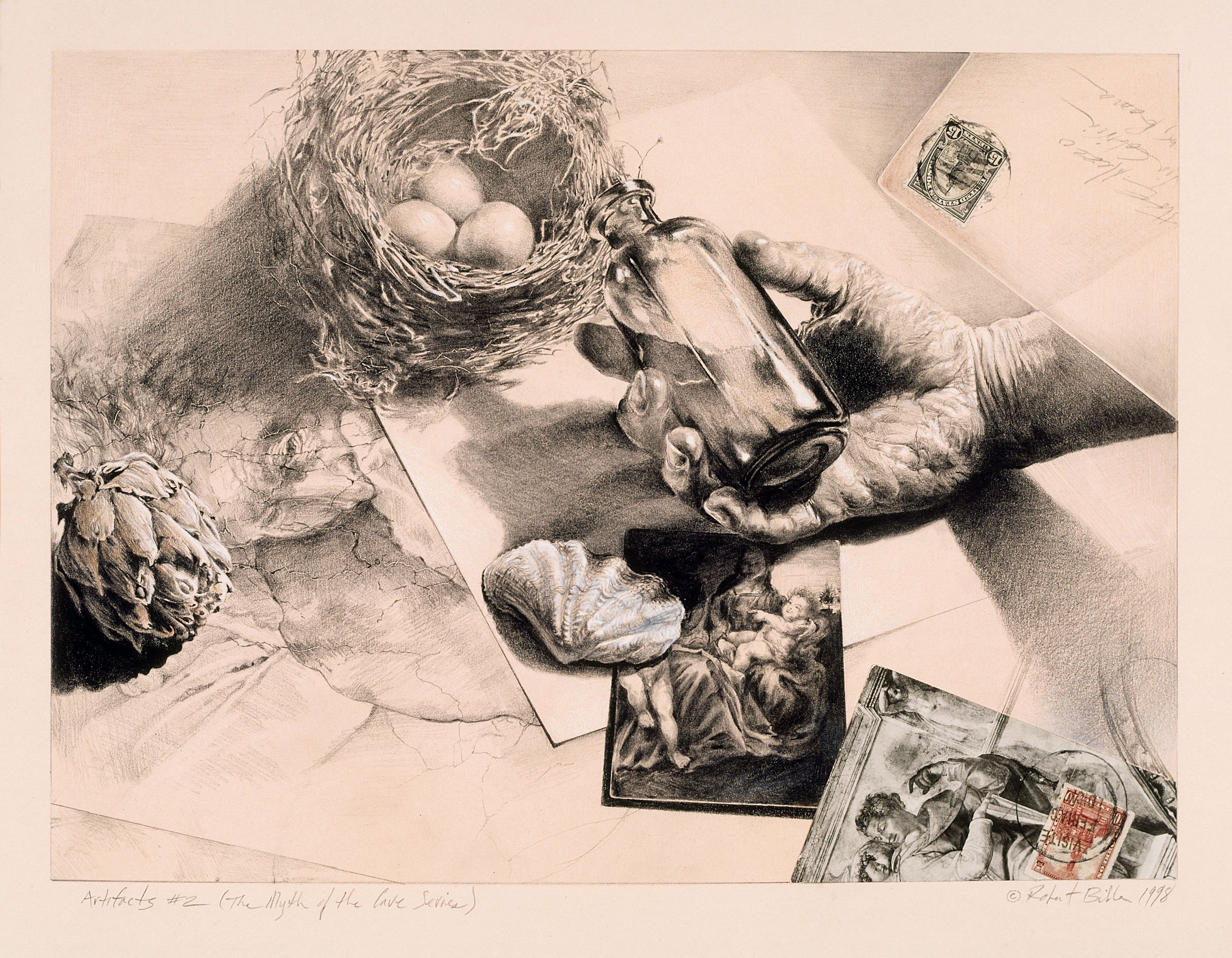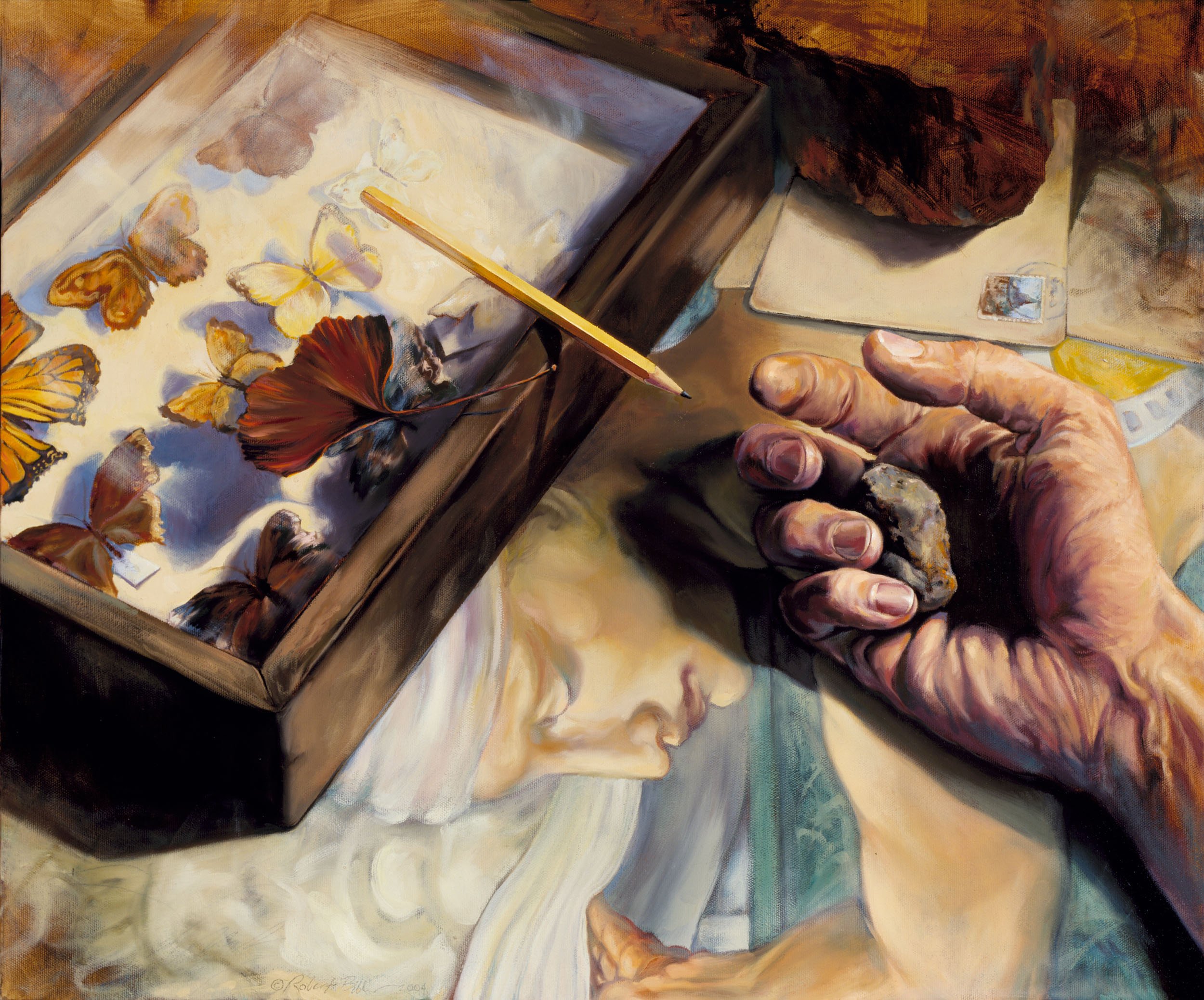
1995 – 2005
Still Life Investigations and Mythical Art Journeys, pt.1
Levitation / 2001 / Pastel, Conté, and charcoal on tan paper / 18.25” x 26.5”
Studio Window Study #3 / 2002 / Oil on paper / 9.25” x 14.5”
Still Life with Butterflies & Michelangelo’s Libyan Sibyl / 2004 / Oil on canvas / 20” x 30”
Still Life with Iron Ring and St. Jerome (after Michelangelo) / 2004 / Graphite, color pencil, collage on paper /10” x 13”
The Circle and the Spiral (After Michelangelo’s Eritrean Sibyl) / 2005 / Pastel and conté on grey paper / 22.5” x 30” / Collection of the Maryhill Museum of Art
The Equiangular Spiral (Homage to Del Sarto) / 2005 / Pastel, charcoal, Conté on tan paper / 22.5” x 30”
The War of the Hemispheres / 2005 / Pastel and conté on grey paper / 22.5” x 30” / Collection of the Hallie Ford Museum of Art
Camera Obscura--The Myth of the Cave #1 (Drawing on the 100th Anniversary of Motion Pictures) / 1995 / Conté and oil glaze on paper / 30.25” x 33.25” / Collection of the Portland Community College Foundation
The Gate / 1995 / Graphite color pencil, collage on paper / 12.25” x 7.5”
The Revelation #2 / 1995 / Mixed drawing media, oil glaze, collage on paper / 42.25” x 30.5”
Still Life With Ginkgo / 1995 / Graphite, color pencil, collage on paper / 9” x 8.125”
Still Life With Stone / 1995 / Graphite, color pencil, collage on paper / 9” x 8.125”
Still Life With Vapor, (Homage to Del Sarto) / 1995 / Graphite, color pencil, collage on paper / 8” x 9”
Studio Window #2 (Homage to Hitchcock) / 1995 / Conté and color pencil on paper / 22.5” x 30”
Imperfect Orbit (Holbein’s Hands / Defenestration #2) / 1997 / Oil on birch panel / 32” x 48”
Searching for Leonardo’s Cave (The Myth of the Cave Series; after Leonardo) / 1997 / Mixed painting and drawing media on paper / 60” x 40”
The Submersion (The Myth of the Cave #2; after Michelangelo) / 1997 / Mixed painting and drawing media on paper / 59” x 40”
Venice Passage (The Myth of the Cave Series) / 1997 / Graphite and color pencil on paper / 23.875” x 16.25”
Artifacts #1 (The Myth of the Cave Series) / 1998 / Graphite, color pencil, collage on paper / 14.5” x 15.5”
Artifacts #2 (The Myth of the Cave Series) / 1998 / Graphite, color pencil, collage on paper / 9” x 12.5”
Evidence from the Cave (The Myth of the Cave Series) / 1998 / Conté and pastel pencil on paper / 22.25” x 26.625” / Collection of Chemeketa Community College
Evidence from the Cave #2 (The Myth of the Cave Series) / 1998 / Conté and pastel pencil on paper / 22.25” x 30” / Collection of Chemeketa Community College
Still Life with St. Jerome (after Michelangelo) / 2001 / Oil on canvas / 20” x 24”
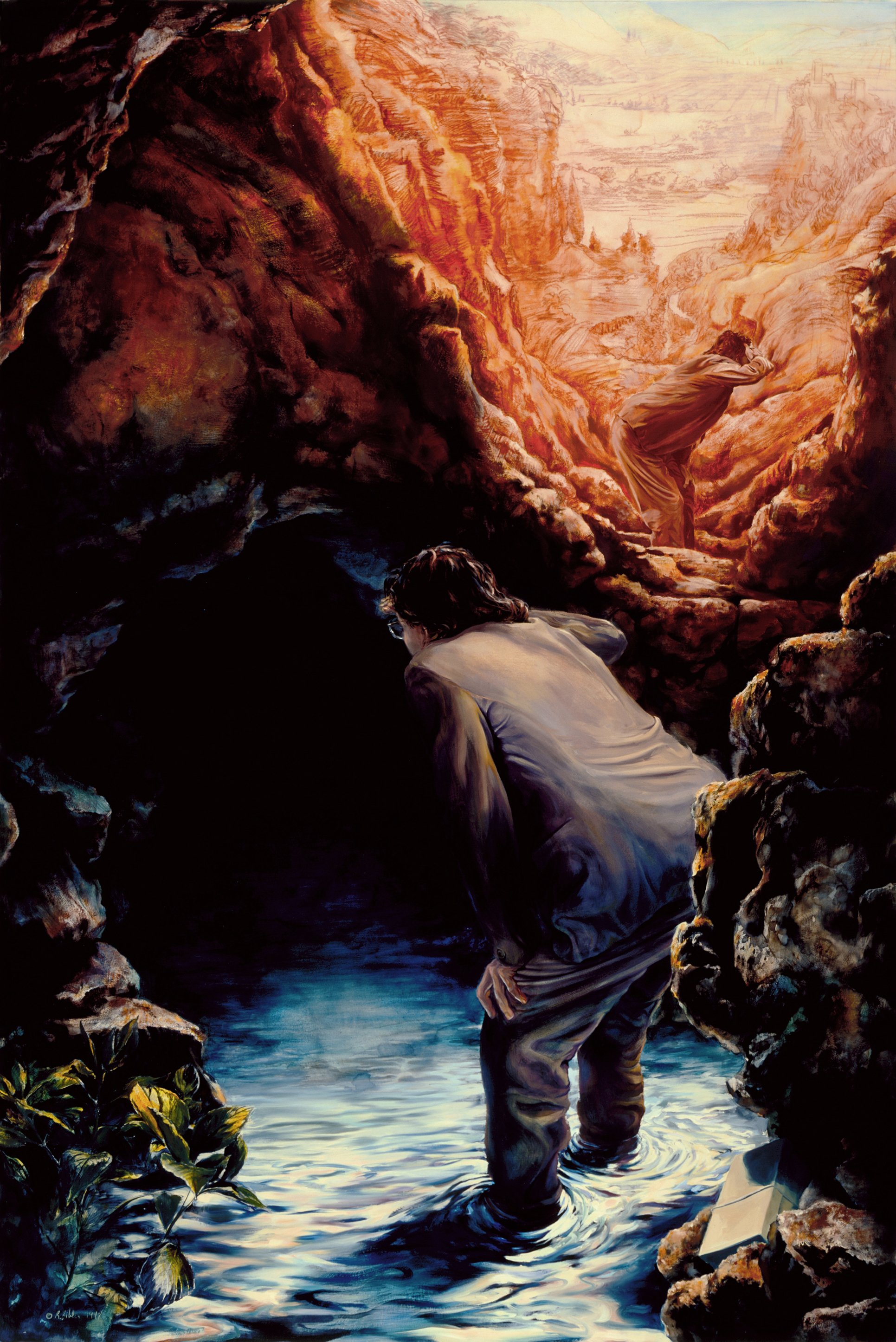
Searching for Leonardo’s Cave (The Myth of the Cave Series; after Leonardo) / 1997 / Mixed painting and drawing media on paper / 60” x 40”
A mythical pilgrimage of the artist is set in an imaginary Italian landscape. Searching for an elusive cave, the artist wanders through a countryside depicted as real, yet existing partly as a line drawing. In fact, the distant landscape in the upper right quadrant is my copy of a detail from Leonardo’s Landscape Drawing for Santa Maria Della Nave, (albeit reversed), dated August 5, 1473.
Regarded as the first true landscape drawing in Western art, Leonardo’s pen and ink rendering depicts the kind of wild, rocky, forested terrain that can be found around Vinci, the town of Leonardo’s youth, asserts biographer Serge Bramly (Leonardo: The Artist and the Man, 1988). Bramly quotes one of Leonardo’s notebook entries, “from about the same period” as the drawing, in which Leonardo describes a memorable experience hiking in such a landscape:
“Driven by an ardent desire and anxious to view the abundance of varied and strange forms created by nature the artificer, having traveled a certain distance through overhanging rocks, I came to the entrance of a large cave and stopped for a moment, struck with amazement, for I had not suspected its existence. Stooping down, my left hand around my knee, while with the right I shaded my frowning eyes to peer in, I leaned this way and that, trying to see if there was anything inside, despite the darkness that reigned there; after I had remained thus for a moment, two emotions suddenly awoke in me: fear and desire––fear of the dark, threatening cave and desire to see if it contained some miraculous thing.”
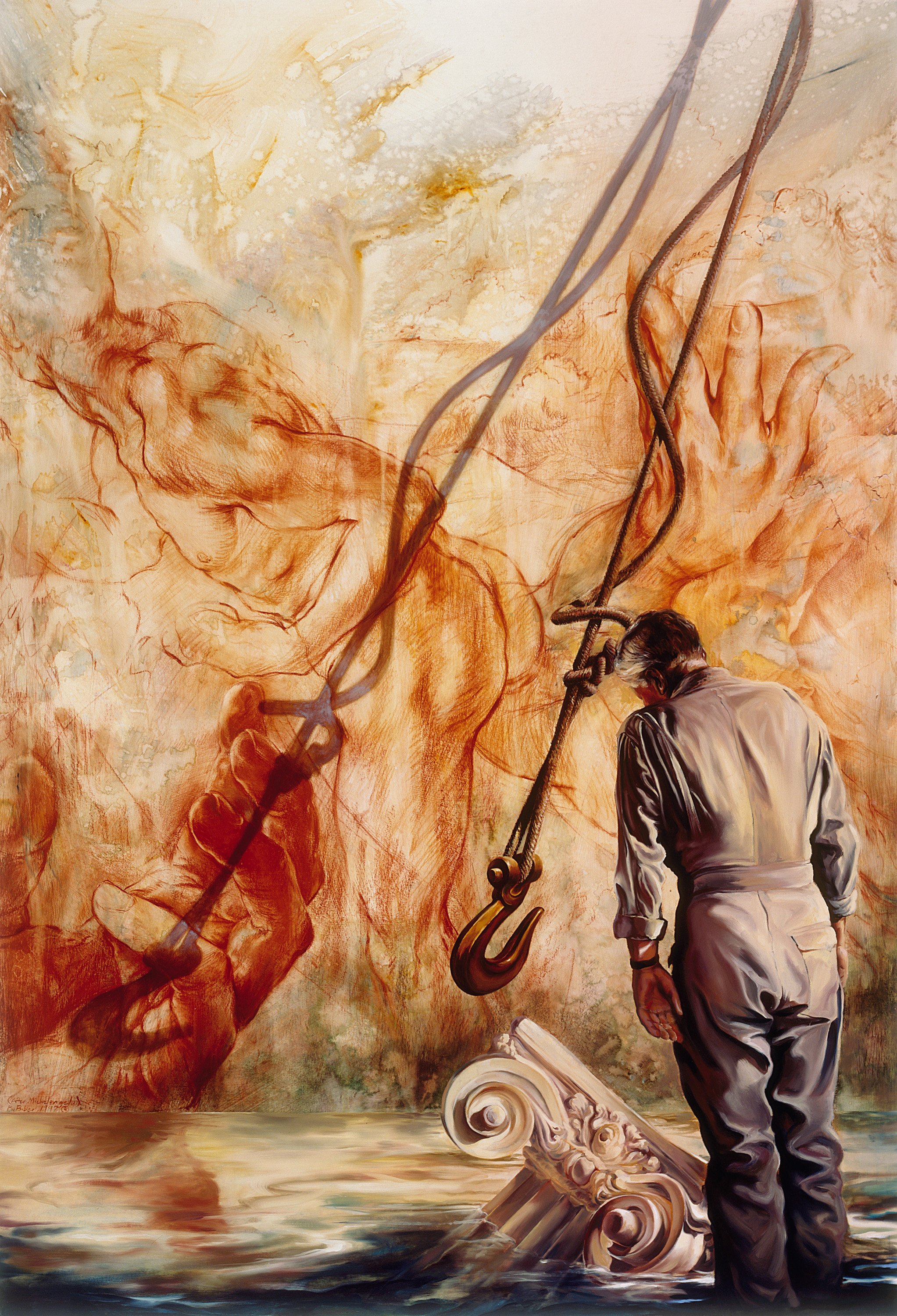
The Submersion (The Myth of the Cave #2; after Michelangelo) / 1997 / Mixed painting and drawing media on paper / 59” x 40”
The Submersion is one of my series of whimsical, mythical art history depictions and allegories. The background male nude is a “quotation,” a precise copy of a small Michelangelo sketch, Young Man Walking to the Left (Teylers Museum, Haarlem). As an homage to Michelangelo, I have given it larger-than-life scale and then pitched it diagonally, the figure striding leftward into the past. The drawings of hands are original studies, as is all the remaining imagery: an unsettling encounter before a cavern wall or deteriorating fresco, a pendulum, and a classical column submerged in the stream of time – or in treacherous water, perhaps, with intimations of calamity and deluge. The title alludes to Plato's “Allegory of the Cave,” questioning our ability to distinguish reality from illusion.
I first developed this fanciful imagery in a drawing, Elevation/Submersion Study, in 1994. One year later, I traveled to Italy. At the Vatican Museum, I saw the spectacular Laocoön sculpture, unearthed in Rome in 1506. Michelangelo had supervised this remarkable resurrection. Then, in Florence at the San Lorenzo cathedral, I was permitted access through a trap door near the Medici Chapel to a low barrel-vaulted chamber where Michelangelo sketched life-size nude figure studies directly on the bare, subterranean concrete walls with black and red chalk, figures not unlike my imaginary depiction a year earlier in Elevation/Submersion Study. These experiences struck me as an odd confirmation of the resonance of my little drawing, prompting me to undertake this large 1997 version.
